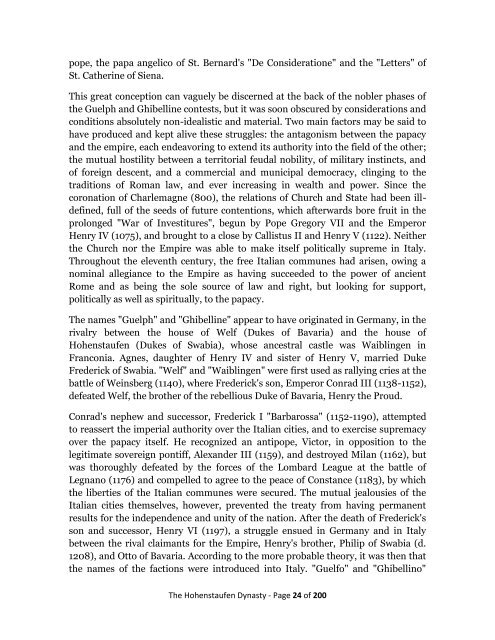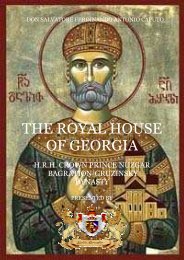here - Nobility Associations
here - Nobility Associations
here - Nobility Associations
Create successful ePaper yourself
Turn your PDF publications into a flip-book with our unique Google optimized e-Paper software.
pope, the papa angelico of St. Bernard's "De Consideratione" and the "Letters" of<br />
St. Catherine of Siena.<br />
This great conception can vaguely be discerned at the back of the nobler phases of<br />
the Guelph and Ghibelline contests, but it was soon obscured by considerations and<br />
conditions absolutely non-idealistic and material. Two main factors may be said to<br />
have produced and kept alive these struggles: the antagonism between the papacy<br />
and the empire, each endeavoring to extend its authority into the field of the other;<br />
the mutual hostility between a territorial feudal nobility, of military instincts, and<br />
of foreign descent, and a commercial and municipal democracy, clinging to the<br />
traditions of Roman law, and ever increasing in wealth and power. Since the<br />
coronation of Charlemagne (800), the relations of Church and State had been illdefined,<br />
full of the seeds of future contentions, which afterwards bore fruit in the<br />
prolonged "War of Investitures", begun by Pope Gregory VII and the Emperor<br />
Henry IV (1075), and brought to a close by Callistus II and Henry V (1122). Neither<br />
the Church nor the Empire was able to make itself politically supreme in Italy.<br />
Throughout the eleventh century, the free Italian communes had arisen, owing a<br />
nominal allegiance to the Empire as having succeeded to the power of ancient<br />
Rome and as being the sole source of law and right, but looking for support,<br />
politically as well as spiritually, to the papacy.<br />
The names "Guelph" and "Ghibelline" appear to have originated in Germany, in the<br />
rivalry between the house of Welf (Dukes of Bavaria) and the house of<br />
Hohenstaufen (Dukes of Swabia), whose ancestral castle was Waiblingen in<br />
Franconia. Agnes, daughter of Henry IV and sister of Henry V, married Duke<br />
Frederick of Swabia. "Welf" and "Waiblingen" were first used as rallying cries at the<br />
battle of Weinsberg (1140), w<strong>here</strong> Frederick's son, Emperor Conrad III (1138-1152),<br />
defeated Welf, the brother of the rebellious Duke of Bavaria, Henry the Proud.<br />
Conrad's nephew and successor, Frederick I "Barbarossa" (1152-1190), attempted<br />
to reassert the imperial authority over the Italian cities, and to exercise supremacy<br />
over the papacy itself. He recognized an antipope, Victor, in opposition to the<br />
legitimate sovereign pontiff, Alexander III (1159), and destroyed Milan (1162), but<br />
was thoroughly defeated by the forces of the Lombard League at the battle of<br />
Legnano (1176) and compelled to agree to the peace of Constance (1183), by which<br />
the liberties of the Italian communes were secured. The mutual jealousies of the<br />
Italian cities themselves, however, prevented the treaty from having permanent<br />
results for the independence and unity of the nation. After the death of Frederick's<br />
son and successor, Henry VI (1197), a struggle ensued in Germany and in Italy<br />
between the rival claimants for the Empire, Henry's brother, Philip of Swabia (d.<br />
1208), and Otto of Bavaria. According to the more probable theory, it was then that<br />
the names of the factions were introduced into Italy. "Guelfo" and "Ghibellino"<br />
The Hohenstaufen Dynasty - Page 24 of 200



